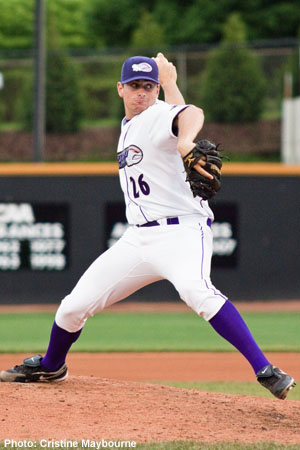
The Chicago White Sox general manager Kenny Williams gets a lot of guff from the sabermetric community for his, at times, curious personnel moves. But if he keeps grabbing 5th round draft picks like Daniel Hudson, he can keep defying the odds. The 6-foot-4, 220-pounder and played collegiately at Old Dominion University. He's made two appearances out of the bullpen for the White Sox this September -- totaling 70 pitches -- but before we get to the PITCHf/x, let's supplement what we'll see with a scouting report.
According to this report from mid-August Hudson has a four pitch mix: four-seam fastball (91-93 MPH but fell to 89-90 after the first three innings), a two-seam fastball (85-87), a change-up (around 82), and a slider (81-82, but can subtract more into the 78 MPH range).
A quick gander at Hudson's statistical prowess shows big strikeout numbers coupled with very good walk rates. However, as he's ascended through the ranks, his ground-ball percentage has decreased, and in the 103 batters faced sample in Triple-A Charlotte, he was only inducing 35% ground balls. Certainly this doesn't spell doom for him, but I always like my pitchers to keep the ball on the ground when it does get put in play. It's not a major red flag, but it's something to keep an eye on.
Now, onto the PITCHf/x goodness. First up, his average release points from the catcher's view:

In watching the video of him pitching for the White Sox, he does look to drop a lot in his delivery and he comes from what looks to be a pretty low-3/4 arm slot. The result is a release point around the 5-foot mark -- nearly one-and-a-half-feet shorter than Hudson's frame.
Here are his total release points:

The chart above corroborates the average release points. There isn't much to transcribe from his slider release point thus far, as he's only thrown nine of them. However, of those nine, all have been coming from a bit higher than his change-up and fastball release points. The difference in release points is not drastic but at the major league level, any little advantage a hitter can gain will be noticed quickly. It's worth keeping an eye on moving forward.
Here's the strike zone plot for all 70 pitches Hudson's thrown in his two appearances:

He's filling up the entire zone, that's for sure. He's shown a good ability to pitch down in the zone (which you can see on the 1st base view of the pitch flight graph below) and command his pitches.
Here's how Hudson's attacked left and right-handed hitters this year, as well as his total pitch selection:

He's yet to throw a slider to a left-handed hitter, despite the fact that 10 of the 19 batters he's faced this year, have been left-handed. He's much more balanced against righties, and on the whole seems to be about league-average in his pitch mix.
Finally, the pitch flight paths:

His fastball (blue line; 94.0 MPH) shows some arm-side run but not much sink at all. I wouldn't expect him to hold 94 MPH velocity throughout his starts because that's not something most starting pitchers in the major leagues do. So I think the 91-93 MPH scouting report from earlier is likely accurate. He's probably able to average 94 because he's pitching in short bursts out of the bullpen for Chicago.
Here is another illustration of his slider (white line; 83.6 MPH) being released noticeably above his other two pitches. That aside, the pitch is pretty 12-to-6 in it's break with some good downward action. It's hard to gauge though, with just nine thrown thus far.
His change-up (orange line; 83.9 MPH) has good sink and some great arm-side run. Of the three pitches, this looks like his best. The tight release point of this pitch in relation to his fastball, coupled with the diving action he gets on it, makes it a very deceptive pitch. I like it.
Daniel Hudson is sitting at 157.2 innings pitched in 2009, his first full professional season, so I can't see him pitching a ton more down the stretch. If this were any other general manager and team in the majors, I'd feel comfortable predicting where he'd start 2010, but Kenny Williams basically doesn't do anything that's predictable. If pressed, though, I'd say he starts next year in Triple-A Charlotte.
All of the usual caveats apply here:
1. I'm not a PITCHf/x guru, I just play one on the internet.
2. The data is a limited sampling of pitches.
3. The PITCHf/x system isn't infallible.
4. Pitch classifications are at my discretion, and may be wrong.
5. This data should always be accompanied with multiple first-hand scouting reports when looking at someone so young in his major league career.
Please join in the discussion on Daniel Hudson in our forums >>>
Mike Rogers runs his own blog, Fire Jim Leyland (no, he doesn't want him fired anymore). He also contributes to a San Diego Padres blog, Friar Forecast, and at the great sabermetric blog Beyond the Boxscore. He can be reached at mrogers@projectprospect.com
